| Listing 1 - 10 of 10 |
Sort by
|
Multi
ISBN: 951880155X Year: 1988 Volume: vol 71 Publisher: Turku : Turun Yliopisto,
Abstract | Keywords | Export | Availability | Bookmark
 Loading...
Loading...Choose an application
- Reference Manager
- EndNote
- RefWorks (Direct export to RefWorks)
Book
Abstract | Keywords | Export | Availability | Bookmark
 Loading...
Loading...Choose an application
- Reference Manager
- EndNote
- RefWorks (Direct export to RefWorks)
Anaerobic bacteria. --- Bacteriology, Pathogenic. --- Microbiology --- Schizomycetes. --- Bacteria. --- Bacteria, Anaerobic. --- Bactéries anaérobies. --- Bactéries. --- Research.
Periodical
ISSN: 10759964 Publisher: London Academic Press
Abstract | Keywords | Export | Availability | Bookmark
 Loading...
Loading...Choose an application
- Reference Manager
- EndNote
- RefWorks (Direct export to RefWorks)
General microbiology --- Anaerobiosis --- Bacteria, Anaerobic --- Bacterial Infections --- Fungi --- Protozoa --- Anaerobic bacteria --- Bacterial diseases --- Anaérobiose --- Bactéries anaérobies --- Maladies bactériennes --- Champignons --- Protozoaires --- Periodicals. --- Périodiques --- Anaérobiose --- Bactéries anaérobies --- Maladies bactériennes --- Life Sciences --- Biology --- Micro and Molecular Biology
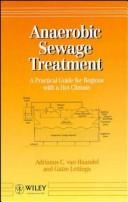
ISBN: 0471951218 9780471951216 Year: 1994 Publisher: Chichester New York Singapore Wiley
Abstract | Keywords | Export | Availability | Bookmark
 Loading...
Loading...Choose an application
- Reference Manager
- EndNote
- RefWorks (Direct export to RefWorks)
Anaerobic bacteria --- Anaërobe bacteriën --- Bacteria [Anaerobic ] --- Bacteriën [Anaërobe ] --- Bactéries anaérobies --- Boues d'epuration [Digestion des ] --- Sewage sludge digestion --- Zuiveringsslib-vertering --- Anaerobic bacteria. --- Sewage sludge digestion. --- Agrotechnology and Food Sciences. Engineering --- Waste treatment --- Waste Water Treatment --- Waste Water Treatment.
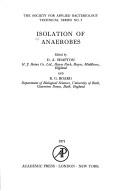
ISBN: 0126388407 9780126388404 Year: 1971 Volume: 5 Publisher: London Academic press
Abstract | Keywords | Export | Availability | Bookmark
 Loading...
Loading...Choose an application
- Reference Manager
- EndNote
- RefWorks (Direct export to RefWorks)
Anaerobic bacteria --- Bactéries anaérobies --- Bacteriology --- Cultures and culture media --- -Microbiology --- Bacteria, Anaerobic --- Bacteria --- Anaerobic bacteria. --- Cultures and culture media. --- -Cultures and culture media --- Bactéries anaérobies --- Bacterial cultures --- Cultures (Biology) --- Bacteriology - Cultures and culture media
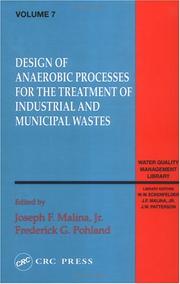
ISBN: 0877629420 0877629447 9780877629443 9780877629429 Year: 1992 Volume: 7 Publisher: Lancaster : Technomic Pub. Co.,
Abstract | Keywords | Export | Availability | Bookmark
 Loading...
Loading...Choose an application
- Reference Manager
- EndNote
- RefWorks (Direct export to RefWorks)
Sewage --- Anaerobic bacteria. --- Factory and trade waste --- Refuse and refuse disposal --- Purification --- Biological treatment. --- Biodegradation. --- Eaux usées --- Bactéries anaérobies. --- Déchets --- Épuration --- Traitement biologique. --- Élimination --- Biodégradation --- Biodégradation. --- Sewage - Purification - Biological treatment --- Anaerobic bacteria --- Factory and trade waste - Biodegradation --- Refuse and refuse disposal - Biodegradation
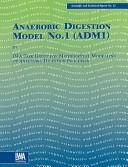
ISBN: 1900222787 Year: 2002 Publisher: London : IWA,
Abstract | Keywords | Export | Availability | Bookmark
 Loading...
Loading...Choose an application
- Reference Manager
- EndNote
- RefWorks (Direct export to RefWorks)
The IWA Task Group for Mathematical Modelling of Anaerobic Digestion Processes was created with the aim to produce a generic model and common platform for dynamic simulations of a variety of anaerobic processes. This book presents the outcome of this unde
Sewage --- Sewage sludge digestion --- Anaerobic bacteria --- Méthanisation --- Boues d'épuration --- Eaux usées --- Bactéries anaérobies. --- Purification --- Biological treatment --- Mathematical models. --- Modèles mathématiques. --- Digestion. --- Épuration --- Traitement biologique. --- Méthanisation --- Boues d'épuration --- Eaux usées --- Bactéries anaérobies. --- Modèles mathématiques. --- Épuration
Book
ISBN: 0965022609 9780965022606 Year: 1996 Publisher: Nashville, Tenn. : Archae Press,
Abstract | Keywords | Export | Availability | Bookmark
 Loading...
Loading...Choose an application
- Reference Manager
- EndNote
- RefWorks (Direct export to RefWorks)
Anaerobic bacteria --- Environmental engineering --- Environmental protection --- Factory and trade waste --- Refuse and refuse disposal --- Water --- Technique de l'environnement. --- Environnement --- Bactéries anaérobies --- Déchets industriels --- Déchets --- Eau --- Biotechnologie appliquée à l'environnement. --- Purification --- Biodegradation --- Biological treatment --- Protection. --- Applications industrielles. --- Biodégradation. --- Élimination --- Épuration --- Traitement biologique.
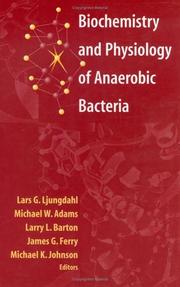
ISBN: 9780387955926 0387955925 9780387227313 9786610145881 1280145889 0387227318 Year: 2003 Publisher: New York, New York : Springer,
Abstract | Keywords | Export | Availability | Bookmark
 Loading...
Loading...Choose an application
- Reference Manager
- EndNote
- RefWorks (Direct export to RefWorks)
During the past twenty years, multitudes of exciting discoveries in the field of anaerobic bacteria have been made. Biochemistry and Physiology of Anaerobic Bacteria explores the full range of these microorganisms. Many anaerobes have been found to have the uniquely fascinating quality of being able to survive, indeed even thrive, in extreme environments. Anaerobic bacteria often do not require oxygen, can survive extremes in temperature, and can withstand the presence of toxins and heavy metals. In addition, these organisms have very different metabolic processes than "conventional" microorganisms. The wide diversity of metabolism in anaerobes is only part of the story. They have distinct energies, cytochromes, electron transport proteins, hydrogenases and dehydrogenases. Their molecular biology, physiology, and ability to use many types of electron receptors (CO2, sulfur, nitrogen and metal oxides) are also extraordinary. With practical applications ranging from wastewater treatment to food storage issues, clinical diagnosis and treatment of a wide range of medical conditions to decontamination of heavy metal exposures Biochemistry and Physiology of Anaerobic Bacteria will prove indispensable to researchers and students alike.
Anaerobic bacteria. --- Bactéries anaérobies --- Bacteriën --- Bacteriology. --- Biochemistry. --- Cytology. --- Life sciences. --- Microbiology. --- Anaerobic bacteria --- Environment --- Bacteria --- Organisms --- Environment and Public Health --- Ecological and Environmental Phenomena --- Biological Phenomena --- Health Care --- Phenomena and Processes --- Ecosystem --- Bacteria, Anaerobic --- Biology --- Health & Biological Sciences --- Microbiology & Immunology --- Cell biology. --- Life Sciences. --- Biochemistry, general. --- Cell Biology. --- Monograph --- Cell biology --- Cellular biology --- Cells --- Biological chemistry --- Chemical composition of organisms --- Physiological chemistry --- Chemistry --- Medical sciences --- Microbiology --- Microbial biology --- Microorganisms --- Composition --- Bacteriën
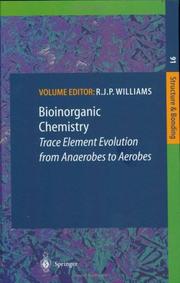
ISBN: 3540635483 3540695958 Year: 1998 Volume: 91 Publisher: Berlin [etc.] : Springer-Verlag,
Abstract | Keywords | Export | Availability | Bookmark
 Loading...
Loading...Choose an application
- Reference Manager
- EndNote
- RefWorks (Direct export to RefWorks)
In this book the first three chapters outline the chemistry of nickel and heme largely associated with anaerobic life and believed to represent reactions which took place some 3-4x109years ago. Nickel has disappeared from the chemistry of man. The fascinating detail of the "primitive" catalysts is of interest to industrial society since very simple feed-stock is used, hydrogen, carbon monoxide and sulphate for example. The fourth chapter switches attention to a metal which became valuable later in evolution, copper, and which is involved with the use of dioxygen. It also has extremely interesting catalytic sites in enzymes. The essence of the volume lies in an appreciation of metallo- enzymes and their changing roles as the environment changed.
Aerobic bacteria --- Anaerobic bacteria --- Anaërobe bacteriën --- Aërobe bacteriën --- Bacteria [Aerobic ] --- Bacteria [Anaerobic ] --- Bacteriën [Anaërobe ] --- Bacteriën [Aërobe ] --- Bactéries anaérobies --- Bactéries aérobies --- Bio-anorganische chemie --- Bio-inorganic chemistry --- Bioinorganic chemistry --- Biological inorganic chemistry --- Chimie bioinorganique --- Inorganic biochemistry --- Chemistry, Bioinorganic --- Trace Elements --- Biochemistry --- Micronutrients --- Chemistry, Inorganic --- Chemistry --- Biological Science Disciplines --- Food --- Growth Substances --- Natural Science Disciplines --- Food and Beverages --- Physiological Effects of Drugs --- Disciplines and Occupations --- Pharmacologic Actions --- Technology, Industry, Agriculture --- Chemical Actions and Uses --- Chemicals and Drugs --- Trace elements --- Speciation --- Inorganic chemistry. --- Biochemistry. --- Cell biology. --- Animal physiology. --- Inorganic Chemistry. --- Biochemistry, general. --- Cell Biology. --- Animal Physiology. --- Animal physiology --- Animals --- Biology --- Anatomy --- Cell biology --- Cellular biology --- Cells --- Biological chemistry --- Chemical composition of organisms --- Organisms --- Physiological chemistry --- Medical sciences --- Inorganic chemistry --- Inorganic compounds --- Physiology --- Composition
| Listing 1 - 10 of 10 |
Sort by
|

 Search
Search Feedback
Feedback About UniCat
About UniCat  Help
Help News
News